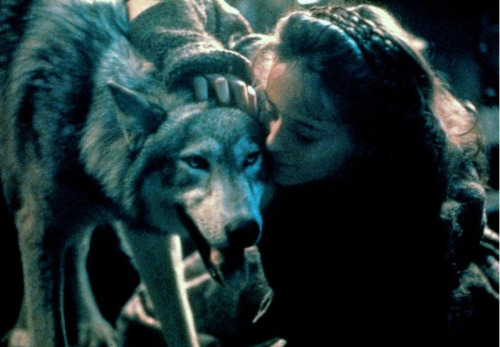Fig. 1. The Company of Wolves poster.
Aggressively Freudian, Neil Jordan’s The Company of Wolves is a surrealistic dive into a young woman’s subconscious. Rife with symbolism, the film takes place in the dream of said young woman – the fact that this is made explicit from the outset means that neither the symbolism nor the incredibly disjointed logic feel heavy-handed or out of place. The dream is ultimately a retelling of the story of Little Red Riding Hood, specifically the older, darker version of the story as a sexual allegory.
The young woman, Rosaleen (Sarah Patterson), lives in a clearly artificial middle-ages town, and is frequently warned by her family, particularly her grandmother, never to stray from the path through the woods for fear of being taken by wolves. Rosaleen’s grandmother has two different definitions of a wolf; the conventional hairy, pack-hunting Canis lupus and the wolf that is ‘hairy on the inside’, specifically werewolves. The film looks at Rosaleen’s unyielding curiosity about what exists off the path - “The imagery is that of a child's fears of wolves and monsters, but they seem to be a representation of how Rosaleen is coping with her own internal changes. She sees wolves that usually (but not always) are symbols of lost innocence and male desire, whereas the "path" that Granny frequently mentions is a symbol for virginity.” (Miller, 2009).
On the threshold of womanhood, Rosaleen is clearly in conflict with her physical desires and changes and the wishes of her parents, who seem to wish to keep their daughter ‘pure’ and untainted by sex and maturity. Ultimately, in the end, when Rosaleen meets a strange hunter when straying from the path and learns that he is a werewolf, she makes the decision to join him as a werewolf herself rather than flee back to her parents, symbolically becoming an adult woman and leaving childhood.
There are also subtle and not-so subtle discussions of domestic violence – “This Red Riding Hood, sharing a single-room cabin with her mother and father, witnesses what in analysis is usually called ‘the primal scene’. The next morning she asks her mother if her father had hurt her. Answers Mother, ‘If there's a beast in men, it meets its match in women, too.’” (Canby, 1985). The wolf as metaphor for men uses humans’ natural fear of and fascination with the wolf to suggest that men are both threatening and entrancing, things not quite understood but with potential to be dangerous.

Fig. 3 Wolf and Rosaleen still.
The scene at the end in which Rosaleen sees the werewolf weep shows that she has come to some kind of understanding of men, and has realized that not all of them are monstrous beasts that seek to rip apart women for their sport. Indeed, the grandmother’s death is particularly important to this; “in order for Rosaleen to gain her independence, there has to be something or someone for her to break free from in the first place. In this case, it is the sheltered life and caution advocated by her grandmother.” (Ireson, 2007). Rosaleen’s apparent lack of compassion for her grandmother’s death is again a metaphor for her willingly shedding the role of child and becoming a grown woman.

Fig. 4 Huntsman transformation still.
The visuals of the film are just as surreal as the content, with the devil showing up in a Rolls Royce and small stone babies hatching out of stork eggs. The film also takes a somewhat contrary approach to the conventions of werewolf transformation – werewolves do not simply grow hair and become odd-looking man-wolves, but each one undergoes a unique metamorphosis, ranging from skin falling off to expose muscle and be replaced by wolf tissue to the wolf pushing out from the werewolf’s mouth. The individuality of each transformation serves to show that each werewolf-as-metaphor-for-men is different, and that they cannot be tarred with the same brush, an important thing for young women to learn as they reach sexual maturity.
Illustration List
Figure 1. Jordan, N. (1984). The Company of Wolves poster. At:https://blogger.googleusercontent.com/img/b/R29vZ2xl/AVvXsEg9ccRCgLSDWsXnDBaoGdSUZE7yQ1TVg5ihBxdBqX57kIONOIHjo4iL9HOGKyvrtGm_BzaHt_6rr_QweIOoUlZLbyTeSZWLQj2ti52UmtQ5ztKKzyGKJpf97XPUhjzQBCd9hV1EB7iv1fI/s1600/Company+of+wolves+poster+2.jpg (Accessed on 04/10/11)
Figure 2. Jordan, N. (1984). Rosaleen and Granny still. At: https://blogger.googleusercontent.com/img/b/R29vZ2xl/AVvXsEi0FI34xazGCQpgQ0T4OrRq9yiYxQ-4_aDm-89uQIjBed-F6SfmD6p0Ht-PoSsgSYbjBfhnBY5Jgy9KcH2IB1HaOM3QYUgOqjqkWxRZ6RxYDYBeUWNanLMXGYnPsNK8mX0UBanfmEAy__Y/s1600/company_of_wolves7.jpg (Accessed on 04/10/11)
Figure 3. Jordan, N. (1984). Wolf and Rosaleen still. At: http://24.media.tumblr.com/tumblr_loqu5t25tB1ql1jpho1_500.jpg (Accessed on 03/10/11)
Figure 4. Jordan, N. (1984). Huntsman transformation still. At: https://blogger.googleusercontent.com/img/b/R29vZ2xl/AVvXsEhVC1OX0WvMNygVEIORx0s_ehWzYB4VBhyphenhyphen81Q3DSirSAs0_4UJM01UhDvypracoFpPyJKgfgLLmOXj3biN3gscfTeGbtdJA22FfBg92mbeTnMoCReVGE9d0c3mNhbKpWqUc156mw-E4eDM/s1600/company+of+wolves+transform.jpg (Accessed on 03/10/11)
Bibliography
Miller, E. (2009) Classic-Horror.com. http://classic-horror.com/reviews/company_of_wolves_1984 (Accessed 03/10/11)
Canby, V. (1985) The New York Times. http://movies.nytimes.com/movie/review?res=9802EFD91138F93AA25757C0A963948260 (Accessed 03/10/11)
Ireson, L. (2007) Talking Pictures. http://www.talkingpix.co.uk/ReviewsCompanyOfWolves.html (Accessed 03/10/11)



"Aggressively Freudian, Neil Jordan’s The Company of Wolves is a surrealistic dive into a young woman’s subconscious."
ReplyDeleteMeg - what a great opening gambit :D I enjoyed this review immensely - it is literate, oozes a kind of critical authority and theoretical ease (the primal scene!) and your use of quotes sparkles with precision. Only problem is - on my laptop at least, the first of your two images are missing - replaced with white blanks + a blue question mark: the same is true of the ONE IMAGE in your Fly 86 review? Any clues?
Thankee Phil! And the images should be fixed, thanks for letting me know. And I added images to the Fly '86 review, wasn't as sickening as I expected it to be. Just please tell me Splice is less squicky than The Fly?
ReplyDelete